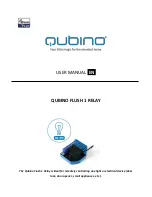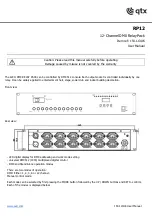
TYPE KAB HIGH IMPEDANCE
BUS DIFFE R E N T I AL RELAY
the relay vertically by means of the two mounting
studs for the type FT projection case or by means
of the four mounting holes on the flange for the semi
flush type FT case. Either of the studs or the mount
ing screws may be utilized for grounding the relay.
The electrical connections may be made directly to
the terminals by means of screws for steel panel
mounting or to terminal studs furnished with the
relay for thick panel mounting. The terminal studs
may be easily removed or inserted by locking two
nuts on the studs and then turning the proper nut
with a wrench.
For detailed FT case information, refer to I.L.
41-076.
External Connections are made per external
connection drawing 265C196.
Note that the Varistor is brought out to a sep
arate terminal to provide flexibility in using the
overcurrent unit. It must be connected in service.
In addition, the contacts of an auxiliary 86 device
should be wired across the relay terminals to pro
tect the Varistor against prolonged overload.
R AT I NG S
Device
Continuous
Overvoltage Unit (V)
250 volts ac
300 volts ac
( 15 seconds)
200 volts ac
Overcurrent Unit (IT)
Lo Range
2.5 Amps
70 Amps (1 second)
Hi Range
10 Amps
280 Amps ( 1 second)
Indicating Contactor Switch (ICS)
0. 2 Amp tap
0.4 Amps
11.5 Amps (1 second)
2.0 Amp tap
3.2 Amps
88 Amps ( 1 second)
Trip Circuit
The overvoltage unit contacts will safely close
30 amperes at 250 volts d-e and the seal-in contacts
of the indicating contactor switch will safely carry
this current long enough to trip a circuit breaker.
The overcurrent unit contacts will safely close
30 amperes at 250 volts d-e, and will carry this
current long enough to trip a breaker.
I.L.
41·337.4A
BU R D E N
The relay burden is approximately 2600 ohms
in the tuned circuit. However, this burden is not
seen by any of the CTS during normal operation or
during an external fault. During an internal fault
the source CT sees a burden composed of the 2600
ohms in parallel with the Varistor resistance plus
the parallel impedance of the unloaded feeder CTS.
The resistance of the Varistor can be calculated
from the volt-ampere curve Figure 2.
AD J US T ME N T S
&
MA I N T E NAN C E
The proper adjustments to insure correct opera
tion of this relay have been made at the factory.
Upon receipt of the relay, no customer adjustments,
other than those covered under "SETTINGS" should
be required.
ACC E P TANC E CH ECK
Overvoltage Unit
(V)
The overvoltage unit has been set at the factory
for 75 volts pickup. If a different pickup is desired,
the relay should be energized from a variable volt
age source. Terminal 8 and 9 should be energized.
The varistor should not be connected when making
adjustments for greater than 200 volts ac. The volt
age unit can withstand 250 volts ac. continuously
and up to 300 volts ac. for 15 seconds.
The pickup is increased by winding the spring
CCW (top view) with a screwdriver or tool style
number 774B180G01 and inserting it in one of the
notches located on the perephery of the spring
adjuster.
Contact Gap - The gap between the stationary
and moving contacts with the relay in the de-ener
gized position should be approximately .030".
Overcu rrent Unit (IT)
The pickup of the overcurrent unit should be
within 10% of its setting.
Indicator Contactor Switch (ICS)
Close the main relay contacts and pass suf
ficient de current through the trip circuit to close
the contacts of the ICS. This value of current should
be not greater than the particular
res
tap setting
being used.
5
www
. ElectricalPartManuals
. com






































